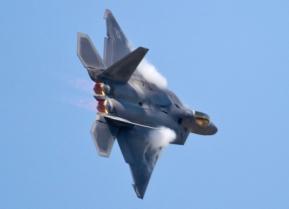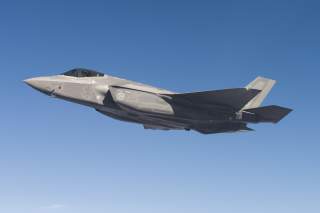The U.S. Air Force of the Future: Hypersonic Weapons, Swarm Strikes and Stealth Fighters
Industry, DARPA and the US military services are already making progress building stealthy drones, vastly expanded ISR technology, drone “swarms” and even early iterations of hypersonic attack drones.
Hypersonic attack drones traveling at five-times the speed of sound, new stealthy drones engineered for strike missions deep into heavily defended enemy territory and drones operated from the cockpit of 5th-generation fighters - are all part of a fast-emerging Air Force vision for the drones of the future, spanning all the way into the 2040s and beyond.
The fundamental strategy is to widen the weapons envelope, expand sensor range and apertures, increase firing distances and - perhaps of greatest importance - conduct effective war operations against advanced enemy fighter jets, missiles and air defenses. It almost goes without saying that much of this strategic thinking, as is quite often discussed, involves a massive Pentagon pivot toward “great-power” warfare preparation.
“Moving forward, we need more capable drones that can function in high-threat scenarios and operate with increased survivability. Stealth needs to be a part of this," Ret. Lt. Gen. David Deptula, Dean of the Mitchell Institute for Aerospace Studies, told Warrior Maven.
Industry, DARPA and the US military services are already making progress building stealthy drones, vastly expanded ISR technology, drone “swarms” and even early iterations of hypersonic attack drones.
“A priority for DARPA's unmanned systems research is to advance future swarming capabilities, allowing warfighters to outmaneuver adversaries in complex urban environments. Swarms of autonomous air and ground robots could provide dismounted troops with distributed perception,” Jared Adams, DARPA spokesman, told Warrior in a written statement.
Naturally, the effort also involves greatly leveraging modernization opportunities with existing unmanned systems, to include the Air Force Reaper, Global Hawk, fast-progressing developmental programs such as DARPA’s air-recoverable Gremlins and the Pentagon’s fighter-jet launched Perdix drones.
Reaper Future
The Air Force is adding new weapons to the Reaper, in part by leveraging an emerging “universal weapons interface.” This would allow the Reaper to more quickly integrate new weapons technology as it emerges and efficiently swap or replace bombs on the drone without much difficulty, senior Air Force weapons developers have told Warrior in previous interviews.
“The MQ-9 Reapers will serve us well for a long time into the future in the kinds of permissive threat environments that allow them to operate in an unconstrained fashion,” Deptula said.
This is something brought to fruition by common standards and IP protocol engineered with adjustable software and hardware configurations, enabling faster integration of new weapons on the Reaper platform.
The Reaper currently fires the AGM-114 Hellfire missile, a 500-pound laser-guided weapon called the GBU-12 Paveway II, and Joint Direct Attack Munitions or JDAMs which are free-fall bombs engineered with a GPS and Inertial Navigation Systems guidance kit.
One possibility for the Reaper drone, currently being explored, could be the addition of the GBU-39B or Small Diameter Bomb, senior Air Force weapons developers told Warrior in a prior interview.
There are many potential advantages to adding to the arsenal of weapons able to fire from the Reaper. These include an ability to strike smaller targets, mobile targets or terrorists and groups of enemy fighters on-the-move in pick-up trucks as well as enemies at further ranges. This kind of mission scope for the Reaper, Air Force developers say, is expected to vastly increase as the service retires is Predator drone.
The Air Force currently operates more than 100 Reaper drones and has, in recent years, begun configuring the platform with additional fuel tanks to increase range. The Reaper Extended Range, or ER as it’s called, is intended to substantially increase and build upon the current 4,000-pound fuel capacity of the drone with a range of 1,150 miles.
The upgrades to Reaper are designed to add two 1,350-pound fuel tanks engineered to increase the drone’s endurance from 16 hours to more than 22 hours, service officials said.
This trajectory for the Reaper is evolving alongside a separate effort to harness increasingly smaller, lighter-weight sensors, transmitters and receivers. As technology continues to progress toward the miniaturization of sensors, receivers, transmitters and lighter materials are engineered, smaller drones are increasingly expected to perform missions currently reserved to large drone platforms. This includes drone swarms designed to blanket areas with ISR, overwhelm or jam enemy defenses and even operate as expendable attack explosives. By having built-in redundancy through a high volume of small nodes, drone swarms can, according to DARPA’s Adams, bring more “robust and resilient communications.”
Also, at some point in the future it may not be beyond the realm of possibility to arm the Reaper for air-to-air engagements as well, service developers have indicated. The service has already flown unmanned fighter jets and, without question, possesses the technology to engage in air combat with unmanned systems. As would be the case in other instances, current plans call for humans to remain in a role of command and control.
Fighter Jets Control Drones
In a previous interview with Warrior several years ago, former Air Force Chief Scientist Dr. Greg Zacharias cited service efforts to engineer F-22s or F-35s, to control drones from the cockpit, directing strike and reconnaissance missions. Not only would this quicken the kill chain but naturally expand ranges for ISR missions, keeping manned aircraft at safer distances. Unmanned aircraft, operated by fighter jets and manned platforms, could carry weapons, fuel, ammunition or other vital systems necessary to air attack. This would of course also lighten the load on fighters, greatly increasing maneuverability and dogfighting abilities.
Air recoverable drones, slated to become operational over just the next few years, will bring a new phase of mission options enabling longer ranges, improved sensor payloads, advanced weapons and active command and control from the air. This possibility is closer to reality due to DARPA’s Gremlins program which plans to break new ground by launching – and recovering – four drones from an in-flight C-130 next year.
“We are in production of UAVs, planning a first flight in mid-2019, with recovery demonstrations by the end of 2019,” Scott Wierzbanowski, Gremlins Program Manager, told Warrior Maven in a written statement.
Gremlins, which hinges upon higher levels of autonomous navigation, brings a wide swath of improved mission possibilities. These include much longer attack and mission reach, because drones can begin missions while in the air much closer to an objective, without having to travel longer distances from a ground location or forward operating base. Perhaps of even greater significance, air-launched returnable drones can be equipped with more advanced sensor payloads able to conduct ISR or attack missions. Ultimately, DARPA plans to launch and recover Gremlins drones from 5th gen fighters such as the F-35 and F-22, agency statements said.
Drones & Lasers
Air Force drones will one day fire high-tech laser weapons from drones and fighter jets to destroy high-value targets, conduct precision strikes and incinerate enemy locations from the sky.
The first airborne tests are expected to take place by 2021, Air Force officials have said. The developmental efforts are focused on increasing the power, precision and guidance of existing laser weapon applications with the hope of moving from 10-kilowatts up to 100 kilowatts. Air Force weapons developers are also working on the guidance mechanisms to enable laser weapons to stay on-track on a particular target.
Air Force leaders have said that the service plans to begin firing laser weapons from larger platforms such as C-17s and C-130s until technological miniaturization efforts can configure the weapon to fire from fighter jets such as an F-15, F-16 or F-35. Given the state of current technology, cargo planes are better equipped in the short term to transport the requisite amount of mobile on-board power needed for airborne lasers.
The Air Force Research Laboratory is already working on a program to develop laser weapons for drones and manned aircraft to arm air platforms by the mid-2020s. When it comes to drone-fired lasers, there does not yet appear to be a timetable for when they would be operational weapons - however weapons technology of this kind is moving quickly.
Future laser weapons could substantially complement existing ordnance or drone-fired weapons such as a Hellfire missile. Laser weapons allow for an alternative method of destroying targets, rapid succession of fire, reduced expenditure of dollars and, quite possibly, increased precision, service officials have explained. For instance, a key advantage of using laser weapons would include an ability to melt or incinerate an incoming missile or enemy target without necessarily causing an explosion.
Ground testing of a laser weapon called the High Energy Laser, or HEL, has been underway at White Sands Missile Range, N.M., service officials said. The High Energy Laser tests are being conducted by the Air Force Directed Energy Directorate, Kirtland AFB, New Mexico.
Another advantage of lasers is an ability to use a much more extended magazine for weapons. Instead of flying with six or seven missiles on or in an aircraft, a directed energy weapons system could fire thousands of shots using a single gallon of jet fuel, Air Force experts explained.
Expanded, Integrated Surveillance
Would emerging drone surveillance technology, historically thought of as providing a "soda-straw" view of areas below, be able to survey wide-swaths of dispersed terrain across a combat area of operations? Perhaps some stealthy drone platforms, increasingly equipped with advanced sensor technology, could perform some of the wide-area command and control missions currently taken up by the JSTARS - Joint Surveillance Target Attack Radar System


